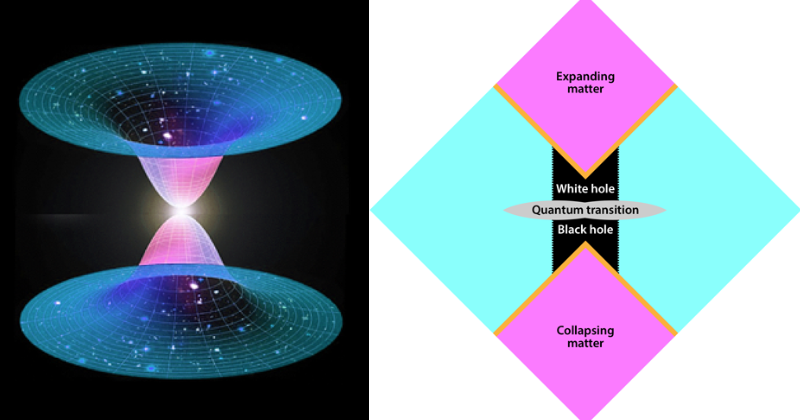In recent theoretical explorations at the forefront of gravitational physics, a thought-provoking proposition has emerged. It has been postulated that the interior spacetime of a homogeneous black hole, when subjected to quantization through the techniques of loop quantum cosmology (LQC), might hold the key to resolving the longstanding enigma of singularities. This intriguing concept suggests that the notorious singularity within black holes could potentially be replaced by a remarkable transition, akin to a metamorphosis from a black hole to a white hole.
However, it's crucial to underscore that this intriguing insight has thus far been derived using a set of effective classical evolution equations. These equations, while offering a promising avenue, rely heavily on a mathematical framework known as the "polymerization scheme." This scheme, intrinsic to loop quantum cosmology, is pivotal in handling the intricacies of the Hamiltonian constraint.

Amidst this evolving discourse, the authors of this particular scholarly work advocate for a novel angle of investigation. They propose harnessing the unimodular formulation of general relativity to undertake an exhaustive examination of the comprehensive quantum dynamics inherent in a simplified cosmological model, often referred to as a "mini-superspace model." This model, a reduced representation of a broader physical system, effectively captures the essential characteristics of a homogeneous black hole interior spacetime.
The unique advantage of unimodular gravity, in this context, becomes apparent in its treatment of the concept of time within cosmological models. By embracing the unimodular approach, the authors are able to derive a distinct Hamiltonian that conforms to a Schrödinger evolution equation. This elegant mathematical maneuver effectively mitigates the intricacies often associated with time-related phenomena in the realm of quantum mechanics.
The authors proceed to meticulously select specific mathematical variables that seamlessly align with the unimodular gravity framework. These judiciously chosen variables serve as the building blocks for the formulation of semi-classical states. Importantly, these states exhibit remarkable agreement with the predictions of the Wheeler–DeWitt theory during later stages of cosmic evolution. Notably, within the framework of loop quantum cosmology, these semi-classical states exhibit a fascinating behavior: they maintain a sharply peaked profile as they progress through the spatial region that would conventionally contain a singularity.
This innovative approach presents an elegantly simplified setup for the comprehensive study of the intricate quantum dynamics intrinsic to these cosmological models. It holds the potential to provide insights into the perplexing issue of regularization ambiguities – challenges that arise when attempting to make sense of mathematical divergences in the context of quantum field theories. By skillfully leveraging the unimodular formulation and drawing from the profound insights of loop quantum cosmology, the authors strive to illuminate the hitherto obscured facets of black hole interiors. This endeavor, rooted in a quest for deeper understanding, seeks to contribute to a more profound comprehension of these captivating cosmic phenomena.
Please follow the below links for previous chapters :-
Chapter 1 - Revealing the secrets of Black Hole
Chapter 2 - Observational history of Black Holes
Chapter 3 - If falling into a Black Hole
Chapter 4 - Death by spaghettification of Black Hole
Chapter 5 - Mystery of Monster Black Holes
Chapter 6 - Crossing a wormhole : Reality Or Science fiction
Chapter 7 - Unveiling the Secrets of Biggest Black Hole
Chapter 8 - Gravity Grasp - Exploring Time Dilation Near Black Holes
Chapter 9 - Formation and Evolution of Black Hole
Chapter 10 - Origin of Universe – An Overview of Big Bang
Chapter 11 - The beginning to the end of the universe : How black holes die
Chapter 12 - Are Aliens Living On Planets Inside Black Hole?
Chapter 13 - Black Hole Sgr A_ unmasked
Chapter 14 - Why it is technically impossible to see the inside & outside of back hole?